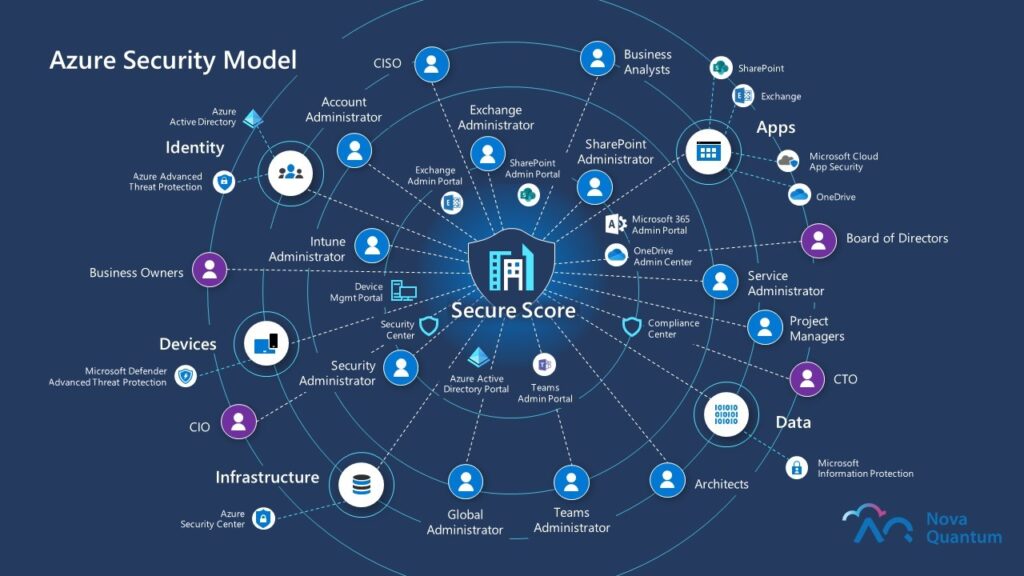Welcome to the world of Cloud Security! Or better Hybrid-Cloud Security. If you’ve ever wondered how your data stays safe as it floats around in the cloud, you’re at the right place. Memorize this: you’re standing in front of a massive, invisible vault that holds everything from your vacation photos to your company’s most sensitive data. This vault is the cloud, and just like any vault, it needs to be secured. But how do you lock up something you can’t even see??
That’s where cloud security comes into play. And today, we’ll dive into the fundamentals of cloud security, with a special focus on Azure Cloud.

Dive into Cloud Security
Imagine you’ve just moved from a cozy, well-guarded neighbourhood (your traditional on-premises data center) to a bustling, vibrant city (the cloud). The city offers endless opportunities and conveniences, but it also comes with new challenges. Just like in real life, you wouldn’t leave your doors unlocked in a big city, would you? Cloud security is the same as locking the doors, setting up alarms, and hiring a security team to protect your new cloud-based assets.
Cloud security has a broad range of practices, technologies, and policies designed to safeguard data, applications, and services that live in the cloud. It’s about ensuring the CIA triangle (Confidentiality, Integrity, Availability) making sure that your data is protected from unauthorized access, tampering or loss, and that it’s available when you need it.
Why is Cloud Security important?
Let imagine this: you are giving a massive barbecue in your backyard, and you’ve invited everyone from your neighbourhood. But there’s a catch – anyone can bring a friend, and soon enough, your cozy gathering turns into a full-blown festival. Now, you’ve got to make sure the food is safe, the guests behave, and no one sneaks off with your prized grill. That’s a bit like what happens when you move to the cloud. Suddenly, your data and applications are accessible from anywhere, by anyone with the right credentials. That’s great for flexibility and productivity, but it also opens up a whole new world of potential risks.
Without proper security, you could be exposing your data to cybercriminals, who are always on the lookout for vulnerabilities. Data breaches can lead to financial loss, reputational damage, and even legal consequences. In short, cloud security isn’t just import or far from your bed show – it’s essential!
Cloud security vs. Traditional security: How is it different?
Let’s break it down with an analogy: if traditional security is like guarding a fortress, cloud security is more like securing a convoy on the move. In the old days traditional security, you had your data center – your fortress – surrounded by firewalls, with all your resources protected within. Your security strategy was all about building walls and controlling access points.
In the cloud, your data isn’t locked away in one place – it’s distributed across multiple servers, possibly in different regions or even different countries. Your convoy is constantly moving, and so are the potential threats. That’s why cloud security is more dynamic, and fluid compared to traditional security. You can’t just build a wall and call it a day. You need to monitor, adapt and respond to threats in real-time.
Another big difference? In traditional security, you owned everything – the hardware, software, network. In Azure Cloud, you’re often sharing resources in multi-tenant environment, which means your data is living alongside data from other organizations. This shared responsibility model is a key aspect of cloud security: while your cloud provider (like Azure and more specific Microsoft) is responsible for security the infrastructure, you’re responsible for securing the data and applications you run on top of it.
Getting started with Azure Cloud Security (ACS)
Now, let’s look deeper into Azure, Microsoft’s cloud juggernaut. Azure provides a wealth of security tools and features, but here’s a pro tip: don’t try to tackle everything at once. Start with the basics and build your security foundation.
- Identity and Access Management (IAM): Just like you wouldn’t hand out keys to everyone in your new city, you shouldn’t give out unnecessary access in the cloud. Azure Active Directory (now Entra ID) is your go-to for managing user identities and controlling who has access to what.
- Network Security: Think of this as setting up fences and checkpoints around your convoy. Use Azure’s Network Security Groups (NSGs) and Azure Firewall to control traffic to and from your resources.
(More details about how to setup hub-spoke or other topologies in later blog posts) - Data Encryption: Imagine putting all your valuables in a safe that only you can unlock. In Azure, you can encrypt data both at rest (stored data) and in transit (data being transferred) to keep it secure.
- Monitoring and Thread Detection: Your convoy needs scouts to keep an eye out of potential dangers on the road. Defender for Cloud and Azure Sentinel provide monitoring, threat detection, and incident response capabilities to help you stay on steps ahead of cyber threats.
- Compliance: Moving to a new city often means new rules and regulations.
Azure offers compliance certifications and tools to help you meet industry-specific security standards and legal requirements.
Wrapping up
Cloud security might seem like an overwhelming task, but with the right approach and tools, it’s entirely manageable – even for beginners. Remember, the cloud offers incredible benefits, but it also requires a new way of thinking about security and applications. With Azure’s robust security features and a solid understand of cloud security fundamentals, you’ll be well on your way to protecting your data in this exciting new environment.
So, whether you’re moving your barbecue to the cloud or just curious about how it all works, keep those doors locked, alarms set, and your eyes on the horizon. The cloud is vast and full of potential, and with the right security foundation and measures, you can explore it with confidence.
Happy cloud computing folks!
